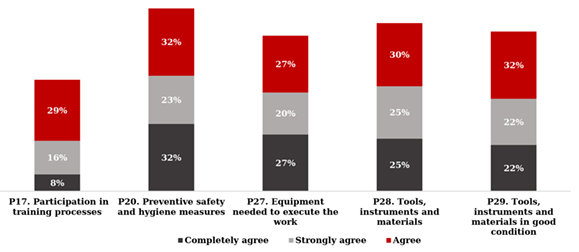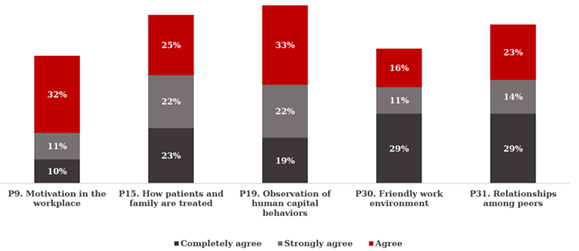1. Introduction
1.1. Health institutions and internal marketing
Health institutions have the mission of providing preventive and curative health care to the population. This is done through a material and human infrastructure that intervenes in all processes to achieve efficient performance in the application of protocols for patients starting at admission and extending throughout their stay and until they are medically discharged. Ideally, this actions should be framed within kind, understanding, sensitive and empathetic behavior for the patients’ physical state and the emotions of family members (Malagón, Pontón, and Galán, 2008, p. 169). Needing medical care can be a difficult experience for both patients and family members, since in some cases, it produces anguish and uncertainty about both the diagnosis and expenses that may arise.
Some patients and their families believe that when hospital workers provide them with medical care, there are omissions that they are willing to excuse if the treatment is friendly or necessary due to their health situation. This implies an understanding that patients’ service and satisfaction depends on the human capital of those (doctors, nurses and administrative or contact personnel) responsible for attending to them. This understanding originated in a concept called internal marketing, which addresses the management of human capital and is implemented by executives, managers, department heads or supervisors and incorporates theory, techniques and rules to inspire colleagues at all levels of the organization to improve service to external customers (Weng, Chen, Lee, Chang, Lin, and Wu, 2016, pp. 507, 508). This justifies the development and implementation of marketing plans focused on human capital (internal markets), the sensitivity of the type of service and the organization’s impact on the client (patients and their relatives). Therefore, to generate work motivation among a hospital’s human capital, actions are needed that make them feel valued and satisfied and evoke a sense of identification with the organization, since the primary objective for practicing medicine or nursing is a sense of vocation, followed by family tradition and scientific and human interest; notably, economic factors are left in the background (Hervas, 2007, pp. 113, 114).
According to Mends-Brewa and Asiamah, 2020 p. 319, internal marketing is evaluated based on the following variables: training and development, internal communication, employee empowerment and reward and recognition. However, the best way to satisfy patients is to view employees as internal customers and to understand and meet their needs and expectations (Sharifabadi and Bideh, 2016, p. 136).
In other words, it is necessary to create a culture of change based on health marketing that promotes the development of human capital in a way that improves service and patient care (De Luke, 2017, p. 81). In the effort to increase job satisfaction and performance in the provision of quality services that promote income, training is a variable that can positively influence hospitals’ internal marketing, since it is necessary to ensure results, improve patients’ perceptions of the quality of medical care and promote word-of-mouth communication (Asiamah, Frimpong Opuni, and Kofi Mensah, 2020, pp. 386, 396).
The administrative roles in applying hospitalization protocols involve the integration of clinical records; provision of a furnished and equipped area (including a bed, clothing, identification bracelet); initial clinical evaluation; equipment for physical examinations; medication administration schedules; studies; procedures; food; delivery of belongings (jewels, money, valuables) to family members to prevent problems; information on rules, routines, services, meal times and visits; internal communication (nursing staff), etc. (Manual de Enfermería, s/f). All of these are functions that highlight the proposed work context in terms of performance and service quality. This context is considered a health care process that involves an institutional responsibility and social commitment to respond to the population’s needs by ensuring the working and personal conditions of the job (Salas Perea, Díaz Hernández, and Pérez Hoz, 2012, p. 612) to competently developing the functions and/or responsibilities involved in the position. In this regard, (Quintana and Tarqui, 2020, p. 131) point out that performance can be improved through supervision, appropriate salaries and punctual pay, which influences productivity and quality of care and, in addition to economic incentives, permits the improvement of skills, infrastructure and working conditions, which in turn reduce risks. In this case, nurses, regardless of whether they have a good performance, warrant the attention of those who run the hospital in order to improve work outcomes. One study concluded that the nurse characteristics that had statistically significant relationships were the duration of service, academic training, low salaries, equipment, work overload, positions that were not aligned with the individual’s specialization, reduced training, pressure and work schedules with minimum flexibility.
Job satisfaction is defined as a positive emotional state that results from work experiences; in contrast, job dissatisfaction causes absenteeism. This is vitally important because it has been found that a lack of autonomy and control generates excessive stress for workers, an issue that has become a great concern for hospital directors. This association is understandable since having permanent contact with suffering, pain and death, caring for sick people and having little autonomy in tasks usually ends leads to a high level of work stress (Pablos-González and Cubo-Delgado, 2015, p. 197).
Thus, the issues of communication, commitment, satisfaction in service, human capital, management and internal customers versus external customers are dynamic and are recurrently addressed in terms of the continuity of organizations in the health care sector. In this document, our research objective is to explore internal marketing in health institutions based on the experiences of the external client (patients’ relatives). The results will allow us to approach the perception of service users (external customers) and to expand the sample in the next phase.
2. Theoretical framework
2.1. Tacit knowledge based on internal marketing
Although much has been written about the importance of knowledge management, (Nonaka, 1994, p. 16) points out that little attention has been paid to the way in which it is created and administered. One dimension of the creation of knowledge management originates in the distinction between tacit knowledge and explicit knowledge. In this context, tacit knowledge has a personal quality, originates in actions, participates in a specific context, inhabits the human mind (Polanyi, 1966 cit. In Nonaka, 1994) and includes cognitive elements in which human beings form functional models of the world, creating and manipulating work analogies that include schemes, paradigms, beliefs and points of view that help people perceive and define their environment (Johnson-Laird, 1983. cit. in Nonaka, 1994, p. 16). The technical element of tacit knowledge integrates knowledge, craft and specific skills that are applied in specific contexts. Based on their epistemology, we consider that tacit and explicit knowledge complement each other; one affects the other, and the two are permanently redefined by the internal and external dynamics of organizations in a process that seeks to document the generated information for analysis, transformation and dissemination, accumulating experiences that contribute to the achievement of objectives and benefit all members of the organization (Garzón and Fisher, 2008, p. 203; González, Rodríguez, and González, 2014, p. 79). In this sense, the personal perspective defines perceived knowledge as “… the result of the accumulation of experience or cases …” (Avendaño and Flores, 2016, p. 207). In this way, remaining in the memory of the subjects favors the exchange of information in the microenvironment of the organizations for either the detection and correction of problems (single-loop learning) or the modification of norms and policies (double-loop learning), (Gürcan, 2014, p. 56). We maintain that when human capital and executive management are linked, weaknesses are identified, and proposals are made to ensure that senior management evaluates and authorizes the changes that the situation demands, thereby promoting collaborative work that meets the needs of the external client.
Internal marketing, a concept that originated with the management of human capital, integrates inspirational techniques and rules into the operation of all sections of the organizational structure that satisfy the needs of stakeholders, improve the system’s services and quality and impact the external client (Ocak and Yavuzalp, 2019, p. 122). Internal marketing is based on experiences and communication processes since it is a strategy to support internal relationships that is promoted by senior management, who recognizes human capital as the most important asset (González et al., 2014, p. 9). As a management strategy, internal marketing addresses all activities within organizations to generate an effective work environment (Zainal Abidin and Roslin, 2019, p. 911), regarding workers as clients and the functions of positions as products (Ocak and Yavuzalp, 2019, p. 117).
Supported by internal policies, internal marketing actions attract, motivate and retain the best employees under work structures that meet individual and organizational needs (Škare and Kostelić, 2015; Jiménez and Gamboa, 2016, p. 11; Villa Gil and Gómez Ospina, 2018, p. 144; Payares, Parra, Navarro, and Naranjo, 2020, pp. 124, 125). Informal internal marketing actions have proven the most effective, influencing the quality of service and the satisfaction of employees and external customers (Sharifabadi and Bideh, 2016, p. 148, 149). This coincides with a study by Pantouvakis (2012, pp. 177, 190, 191) of 478 hospital staff members, including doctors, nurses and those in administrative positions. He identified that instant messaging was used to align the internal and external efforts and objectives of companies and that employee satisfaction could be achieved not only through rewards but also by improving the physical environment or procedural structures of the company. At present, various related theoretical contributions consider internal marketing a set of organized techniques that give value to objectives, strategies and structures for increasing productivity in work scenarios oriented to satisfying the needs of the internal customer (via human capital) and external customers (Araque, Sánchez, and Uribe, 2017, p. 96), making it a management process (Fuentes and Reyes, 2017, pp. 16, 17). This involves an administrative responsibility for solving problems (Fortenberry and McGoldrick, 2016, p. 28,29; Nasab, Rahmani, Enjezab, and Rezaee, 2017, pp. 863, 868).
The preliminary conception of our assumption is as follows (Naghi, 2000, p. 69):
Hi: The experiences of the relatives of patients of health care institutions reflect positive internal marketing in terms of the indicators of equipment and tools for the execution of the work, performance and job satisfaction.
2.2. Leonard Berry’s internal marketing model
Internal marketing models have highlighted the importance of developing the human capital of employees, who are considered internal customers due to the impact of their performance on commercial management (sales). Although the literature describes various models, Leonard Berry’s proposal is consistent with the objective of the present study because it recognizes and identifies human capital as a client that evolves in its capacities, abilities and performance and thus becomes a competitive advantage. Accordingly, to have satisfied employees and develop customer-oriented attitudes that guide perceived quality and customer satisfaction, it is necessary to recognize tasks as products, which implies another dimension of human resources that favors the use of techniques and marketing to attract and retain human capital (Rafiq and Ahmed, 2000, pp. 223, 224; Fuentes, 2009, pp. 196,197; González and Hernández, 2012, p. 54), (Figure 1). This method can improve organizational commitment, making it a planned effort by the organization to motivate employees, increase performance, retain the best employees and provide quality services to its customers, making it a vision of human capital as an “internal customer”. It assumes that employees whose needs are satisfied will be more motivated and committed to providing a high-quality service through the vision (a mental image of a desirable future), reward (based on the services provided) and development components of internal marketing (Suprihanto, Wrangkani, and Meliala, 2018, p. 80). By following the Berry approach, organizations will have satisfied and motivated employees because this method strengthens organizational ties, fulfills institutional philosophies and develops a sense of belonging, which in turn results in optimal service, positive service experiences and solid relationships with the external client and impacts the profitability of the company (Payares, et al., 2020, pp. 129, 130).
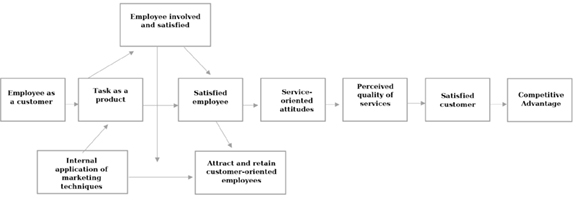
Source: (Ahmed and Rafiq, 2002:15 cit. in Fuentes, 2009 p. 197)
Figure 1 Leonard Berry’s Internal Marketing Model
3. Methodology
The research design was a nonexperimental cross-sectional and exploratory study of internal marketing actions and the experiences of external customers. The sample was a nonprobabilistic convenience sample (Berenson, Levine, and Krehbiel, 2006, p. 221) of 73 subjects with consanguinal ties (Código Civil Federal de México, Art.,296-300), affinity ties (López, 2006, p. 340) or social ties who accompanied a patient during his or her hospital stay; as a result, the subjects experienced the performance of employees who attended them and could assess the value of the hospital’s internal marketing. To identify these actions and explain their impact on the external client (patients’ relatives), the internal marketing variable was operationalized with three indicators (Table 1).
Table 1 Operationalization of the internal marketing variable
| Variable | Conceptual definition | Operational definition | Indicator | Items |
|---|---|---|---|---|
| Internal marketing | Set of policies designed to generate working conditions that attract, motivate and retain the best employees under contracts that meet their needs (Sharifabadi & Bideh, 2016, pp. 148, 149; Pantouvakis, 2012, pp. 177, 190, 191; Škare & Kostelić, 2015; Jiménez & Gamboa, 2016, p. 11) | Evaluated using a 24-item questionnaire with the following 7-point Likert scale response options (Malhotra, 2004, p. 258): Totally agree. Strongly agree. Agree. Undecided. Disagree. Strongly disagree. Totally disagree | Equipment and tools needed for the execution of the work | 5 |
| Labor performance | 14 | |||
| Job satisfaction | 5 |
Source: Authors’ own elaboration.
To identify the degree to which the items measured the indicators that compose the variable, Cronbach’s alpha reliability test was performed (Quero, 2010, pp. 250, 251), and the results indicated high internal consistency.
The operationalization of the indicators that compose the internal marketing variable is explained below:
Equipment and tools for the execution of the work was defined as the set of instruments, materials, tools and safety and hygiene measures that are necessary for the performance of the job and that the employer is obligated to provide (LFT, Article 132, section III). It was operationalized using a questionnaire with 5 items answered using a Likert scale with 7 response alternatives (Table 2).
Table 2 Operationalization of the internal marketing variable
| Variable | Indicator | Items | Cronbach’s alpha |
|---|---|---|---|
| Internal marketing | Equipment and tools needed for the execution of the work | P17. Training processes. | 0.852 |
| P20. Preventive hygiene, safety and protection measures. | |||
| P27. Equipment needed for the execution of the work. | |||
| P28. Tools, instruments and materials needed to provide care. | |||
| P29. Physical state of tools, instruments and materials. |
Source: Authors’ own elaboration.
Labor performance was defined as the set of skills, capabilities and knowledge that equate to human capital for the job (Salas et al., 2012; Quintana and Tarqui, 2020, p. 131) and was evaluated with 14 questions answered using a Likert scale with 7 response alternatives (Table 3).
Job satisfaction was conceptualized as the positive emotional state (Pablos-González and Cubo-Delgado, 2015, p. 197) or attitude of employees while performing their work and was evaluated with 5 questions answered using a Likert scale with 7 response alternatives (Table 4).
The sociodemographic characteristics of the sample (gender, age, level of education, etc.) were determined (Table 5).
Table 3 Operationalization of the internal marketing variable
| Variable | Indicator | Items | Cronbach’s alpha |
|---|---|---|---|
| Internal marketing | Labor performance | P8. Workers’ knowledge of services. | 0.943 |
| P10. Scheduling flexibility. | |||
| P11. Satisfaction with the workplace. | |||
| P12. Satisfaction with job performance. | |||
| P13. Better skills for performing the roles of the position. | |||
| P14. Better capacities for performing the roles of the position. | |||
| P16. Knowledge of the job. | |||
| P18. Compliance with work regulations. | |||
| P21 Intensity of the position. | |||
| P22 Care in the execution of functions. | |||
| P23. Dedication to the execution of the work. P24 Execution of work as required. | |||
| P25.Execution of the work in the necessary time. | |||
| P26. Place in the performance of the position. |
Source: Authors’ own elaboration.
Table 4 Operationalization of the internal marketing variable
| Variable | Indicator | Items | Cronbach’s alpha |
|---|---|---|---|
| Internal marketing | Job satisfaction | P9. Motivation of staff members. | 0.913 |
| P15. Perception of how patients and their relatives were treated by staff members. | |||
| P19. Observation of staff members’ behavior. | |||
| P30. Perception of cordiality in the work environment. | |||
| P31. Perception of relationships among staff members. |
Source: Authors’ own elaboration.
Table 5 Operationalization of sociodemographic characteristics
| Variable | Indicator | Measurement type |
|---|---|---|
| P1. Biological sex | Male | Nominal |
| Female | ||
| P2. Age | Years | Ordinal |
| P3. Civil status | Married, single, divorced, widowed, domestic partnership, other | Nominal |
| P4. Education level | Primary, secondary, preparatory, undergraduate, graduate. | Ordinal |
Source: Authors’ own elaboration.
4. Results and discussion
Regarding the study subjects’ sociodemographic characteristics, the average age was 25 years, with a predominance of women and single civil status (Table 6).
Table 6 Sociodemographic characteristics
| Sex | (N=73) | % |
|---|---|---|
| Male | 23 | 32 |
| Female | 49* | 67* |
| Civil status | (N=73) | % |
| Single | 60* | 82 |
| Married | 7 | 9 |
| Divorced | 2 | 3 |
| Domestic partnership | 2 | 3 |
| Did not answer | 2 | 3 |
Source: Authors’ own elaboration.
The results indicated ascendent-descendent consanguinity ties that were first degree (parents-children), second degree (grandparents-grandchildren), transverse (siblings, uncles) and fourth degree (cousins) (Código Civil Federal de México, Art.,296-300). Other relationships were affinity ties that originated in marriage (López, 2006, p. 340) and social ties (Figure 2).
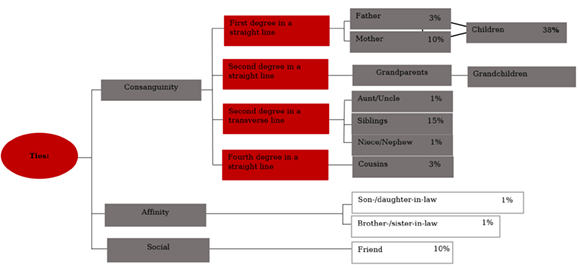
Source: Author own elaboration
Figure 2 Consanguinity, affinity and social ties of patients and family
Below, the frequency distribution for each indicator of the internal marketing variables is presented.
4.1. Internal marketing variable
4.1.1. Indicator: Equipment and tools for the execution of the work. The patients’ relatives perceptions
Regarding whether the staff members have the human capital to perform their functions were distributed across the points of the Likert scale, with a positive trend represented by the response alternatives Totally agree, Strongly agree, Agree. The positive trend was greatest for preventive security and protection measures. In contrast, the study subjects showed indecision regarding the matter of training, which is understandable because training activities are developed in the organizational microenvironment, and their results are evident in staff members’ performance in their role or in the services they provide to the external customers (patients and family members) (Figure 3).
4.1.2. Indicator: Labor performance.
The perceptions of the patients’ relatives was positive, as indicated by Likert scale responses of Totally agree, Strongly agree and Agree. These responses indicated that the staff members who attended to them performed their functions with intensity, care and dedication in an appropriate and timely manner (Figure 4).
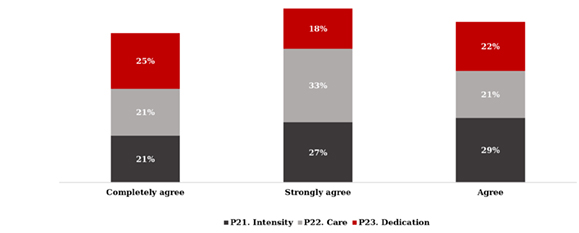
Source: Author own elaboration
Figure 4 Perception of the patient’s family with respect to job performance of Human Capital in Health Care Institutions
In this preliminary intervention regarding the object of study, we found that labor performance was aligned with the Satisfied employee, service-oriented attitudes, perceived quality of services and satisfied customer variables of Berry’s internal marketing model. In reality, by providing staff members with everything they need for optimal performance, it is likely that they will present their best skills, abilities and knowledge because members of health care professions are characterized by a vocation of commitment to health. In terms of workplace skills, abilities and knowledge, the responses of the family members were positive and were distributed among affirmative responses (totally agree).
4.1.3. Indicator: Job satisfaction.
The Likert scale responses of the patients’ relatives showed a positive trend, indicating that the respondents perceived that the human capital generated a pleasant work environment and that staff members had good relationships with their colleagues, were motivated and engaged in good habits during the execution of their functions and treated their colleagues and patients with dignity. (Figure 5), this indicator was similar to the Satisfied employee, Application of techniques, Service-oriented attitudes, Client perception and Competitive advantage variables of the Berry Model.
4.2. Verification of the preliminary assumption
The assumption was presented as follows: Hi: The experiences of patients’ relatives with health institutions indicate positive internal marketing for the indicators of equipment and tools for the execution of the work, performance and job satisfaction. The results of the analysis of the Likert scale responses in this preliminary approach to internal marketing in health institutions show that in terms of the patients’ relatives’ (study subjects’) perceptions of the work environment and socialization level of the staff members (job satisfaction), 81% had a very favorable perception, and 3% had an unfavorable perception; (Table 7). Although the sample was limited in this first approach to the object of study, we believe that it provides adequate evidence to proceed with a subsequent phase of the study (Díaz, 2009, p. 180).
5. Discussion
The implementation of internal marketing practices promotes the satisfaction of human capital needs, which form the basis of collaboration, job stability the business knowledge structure needed to compete in the market. Internal marketing requires effective practices for work interactions at different levels and in different areas of specialization that contribute to development and motivation through systems that encourage training, development, coordination and the design of incentive and empowerment schemes (Wedzerai, Norman, Tinashe, and Tinashe, 2020, p. 187, 189, 190) by directive management. However, the analysis of the theoretical contributions to internal marketing indicate that the fundamental basis of the concept originates from the consideration of human capital as internal customers whose performance impacts the external customer and supports the commercial management of any organization. Therefore, we consider internal marketing actions to be closely related to the Federal Labor Law, specifically Article 132, which addresses the obligations of employees (entrepreneurs, executives, etc.) and highlights the topic of tools and equipment, safety, health and environmental standards, medications and first aid materials, remuneration, dignified and respectful treatment, training, etc. Article 134 provides instructions regarding human capital in terms of optimal performance and communication that supports the fulfillment of labor obligations, solidarity and support from the company and coworkers in cases of accidents or risk.
In our approach to the subject, we assert that there is a corporate responsibility to provide the equipment and tools for employees to execute their work, and this responsibility is comparable to observing the employee as a client and the functions (task) as a product, as operationalized by Berry in his internal marketing model. Berry’s model allows us to agree with other authors that satisfied collaborators are efficient in socializing with their colleagues and clients (Zainal Abidin and Roslin, 2019, p. 909). We also found that having everything necessary to execute job functions favors performance and job satisfaction (operationalization of variables), factors that are noticed and valued by the external client and could constitute a competitive advantage for the company. The retention of human capital and positioning of the organization are shown in Figure 6. It is interesting to highlight the loyalty of external customers, since when their needs are met, they seek to maintain good relations with the workers who served them (Park and Tran, 2018, p. 416).
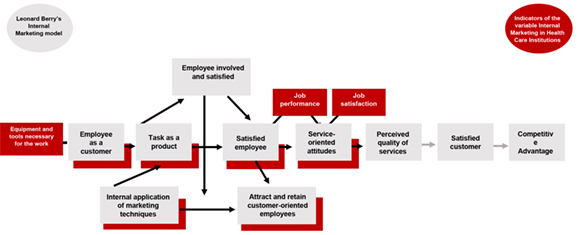
Source: Own elaboration based on the Leonard Berry Model (apud Ahmed and Rafia, 2002:15 cit. in Fuentes, 2009, p. 197)
Figure 6 Internal marketing variable indicators consistent with the Leonard Berry Model
6. Conclusions
This study concludes that internal marketing in health institutions has a favorable impact on the human capital of staff members (doctors, nurses, administrative staff, etc.), who are classified as internal customers. The experiences of patients’ family members were positive (tacit knowledge), which indicates that quality treatment is highly valued and influences patients’ loyalty toward the institution. Therefore, based on the preliminary results regarding the tacit knowledge of internal marketing, the development of a further phase of the study has been proposed to expand the sample to evaluate and generalize the results.














